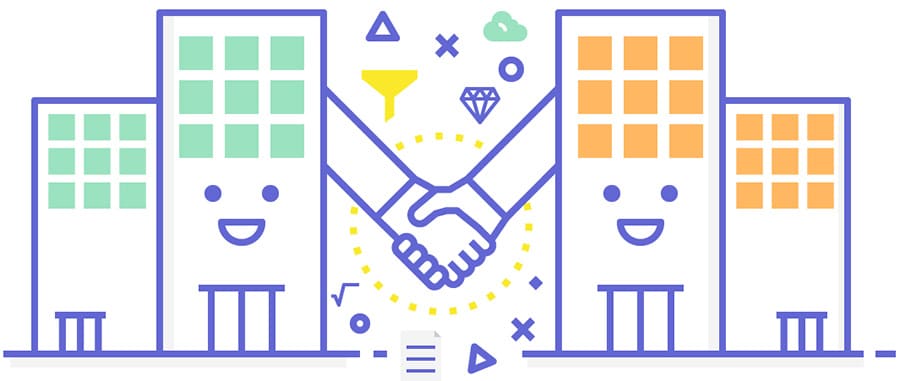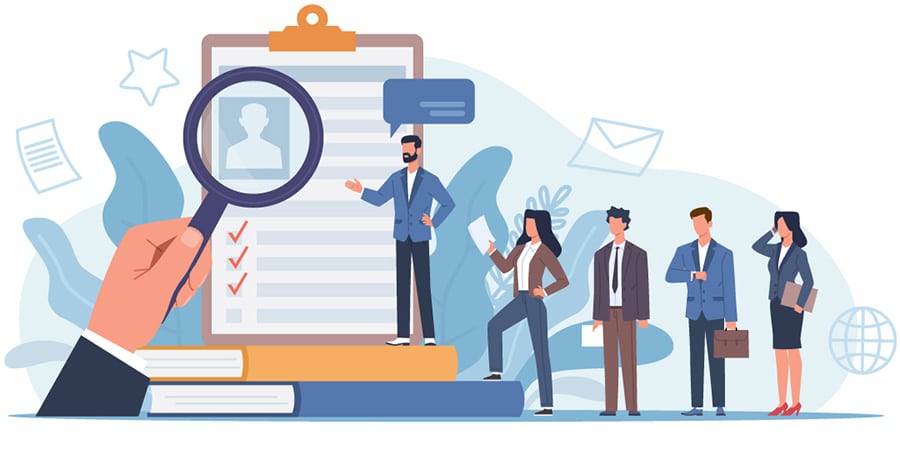What is “B2B”?
A business-to-business company is any entity that provides goods and/or services to (you guessed it) another business. From Software subscriptions and web design to security, industrial equipment, or office supplies, you probably know of more B2B companies than you think. The goal in any B2B business is to build connections and value, educate prospective clients and, ultimately, drive sales.
B2B vs B2C Services
B2C, or Business to Consumer companies, are probably what most of us are familiar with. Grocery stores, car dealerships, and restaurants generally don’t focus too much on selling to other companies, but If your local diner is business to consumer, then the people that sell them ingredients, hold the lease for their building and host their web presence are all business to business companies.
Many businesses provide both types of services. Just think of your favorite sports company that supplies both professional teams and individual consumers with equipment.
ROI, or Return on Investment, is rarely a consideration for the everyday person buying a bag of apples, but very important to the person choosing which apples to stock their shelves with. Marketing to the people who influence the purchasing decisions of a company may be the biggest distinction between B2B and B2C companies.
Common B2B Marketing Channels
- Blogs, video, and social media
- Printed media like pamphlets or trade magazines
- Search Engine Optimization
- Email marketing campaigns
- Industry events and other in-person marketing
Great B2B Examples

Using the Wayback Machine, take a look at some of your favorite companies with a long history of business-to-business marketing. Keep in mind though that not every embedded image is still hosted in the same location, so some results may vary.
Nike
Let’s look at a few really clever things that the world’s most valuable apparel brand has been doing: Constant updates, beautiful high-quality images, they market the lifestyle before the product.
Many seem to expect B2B brands to have a certain sterile intellectualism, but sustainable, consistent Brand Storytelling has always been Nike’s bread and butter. This is a great reminder that sometimes you don’t have to rely on salespeople when your customers do your marketing for you.
Rackspace
B2B companies face a problem: As they move toward analytics-driven marketing, they often start to lose the personal relationships that are at the heart of any good business strategy. 80% of brands think they offer a top-notch customer experience, while only 8% of customers agree with that assessment.
Rackspace is helping to bridge that gap with integration solutions that center customer experience and include them -the people who they are marketing to- more directly. Imagine!
GoDaddy
Small to medium businesses have always been GoDaddy’s lifeblood, but 2020 saw a rapid rework in its marketing strategy to help those businesses make the jump from physical to online sales. At the end of the day businesses relationships truly are a two-way street, and B2B can only work if both businesses are successful.
It seems to be working: In May, they revealed that they now has 19.3 million customers around the globe. In the past 12 months, their revenue has increased 11.5%, and e-commerce has seen a 40% uptick in customers.
Concepts and Best Practices

Lead Generation vs Conversion
Lead Generation is the widest and shallowest portion of your marketing funnel. Generation is driving cold traffic to your site. Done through SEO, Pay per Click advertising, squeeze pages -free offers designed to “squeeze” contact information from customers via digital assets- and more.
This is the time to bring out your Primary Offer.
Lead Conversion is for visitors already familiar with your business. Many companies focus on using word of mouth and paid advertising for generating leads and reserve their webspace for converting those leads into paying customers. Broadly speaking, this encompasses both the middle and bottom portions of your funnel. Having filtered your audience down to something manageable, it’s time to make a sale.
Primary offer: A primary offer serves two purposes: refining your visitor pool and generating leads. This should be something high value for clients and little to no risk for you. A call for them to contact you is the end goal. Whether this is purely introductory or what your secondary offer ultimately leads back to is entirely up to you.
Secondary Offer: 96% of visitors aren’t ready to make a purchase at that moment. Stay in touch, be the first person they think of when they’re ready. This is the Lead Conversion stage and should require some form of commitment from the visitor, either gathering contact information for a one-on-one follow-up or an actual financial transaction.
Remarketing: A remarketing campaign is a great alternative for visitors who made it to your website but didn’t move forward with your primary or secondary offers. This is also an excellent way to show your chops and build trust and commitment with clients who may return for larger-scale projects later.
Personas
“The magic ‘mind reading’ anticipatory service phrase is: ‘If that was me, what would I want?’” – Steve Cokkinias
Let’s go back to the question of buying apples for a moment. If you, as a farmer, were to describe your ideal customer, you might say something like “I want to advertise to the person who decides which apples to buy.” Who is that person, though? “User personas” target specific audiences from a motivation perspective.
Just as your apple buyer could be the head of marketing or a stressed-out manager trying to keep their costs down and shelves filled, assuming that the customers coming to your website only have one motivation can be quite short-sighted. Don’t stop at a job title, actually understand what reasons and mindsets might be driving customers to -or away from- what you have to offer.
Strategy
“You need to get to the future, ahead of your customers, and be ready to greet them when they arrive.” – Marc Benioff
- Define your overarching vision for the company
- Define your market and buyer personas
- Identify which tactics and channels will reach your target audience. Answer questions like which social media platforms and search engines they prefer, which industry events they attend and find any gaps in the market where they aren’t currently being targeted.
- Create your content and run ad campaigns.
- Collect data and improve.
Creating a Marketing Funnel

A marketing funnel is a wide pool of potential clients progressively narrowed via a single through-line. To break that down more clearly, let’s look at each portion of your “funnel” individually.
Top of the Funnel
At the top of the funnel, we have a wide pool of potential clients with a myriad of needs and motivations. 72% of tech marketers and business decision-makers surveyed here agreed that blogs, infographics, and video were the best options at this stage. Just remember that content is key, and content performance and marketing play huge roles in the success of your venture.
Mid-funnel content
The middle of the funnel is the time to bring out your charisma and start wooing potential clients. While your audience base at the top of the funnel was too broad to target individually, by the mid-stage you should have a healthy pool of qualified contacts. At this point, the game shifts from ruling out potential clients to drawing them in. Master the tasteful brag and start bridging the gap between awareness and commitment.
While webinars, webcasts, and virtual events have been extremely successful up til now, keep in mind that most of us are at some stage of burnout in attending online meetings after a year of quarantine. While these are still powerful tools, it’s worth noting that 1 in 7 B2B professionals surveyed here said that they would rather go to the dentist than sit through another web seminar.
Bottom of Funnel content
Many B2B entities excel at top and mid-funnel marketing but provide very little in the way of narrowly focussed, persona-driven content for those potential clients who have already made their way through the pipeline to this point.

Free Custom Mockup
We deliver a free website mockup in 7 days. No future obligation or cost, guaranteed!
At this stage, you want to provide data-driven information. 46% say in-depth white papers, e-books, and customer case studies make the biggest difference. Meanwhile, there’s a growing trend of using infographics featuring customer success stories and testimonials that many find to reinforce a personal connection.
Be obsessive about your analytics and tweak each component individually, such as:
- Ad headlines
- Landing pages
- Offers
- Target Audience
What to look for when hiring a professional

Specializes in Business to Business Web Design
Anyone can call themselves a web designer, but does your firm specialize in business-to-business projects or is that just a buzzword they’ve thrown in, perhaps to beef up their own SEO results? Make sure you’re familiar with their content and ask questions.
At CodeDesign, we understand the challenges and unique opportunities that go with B2B design. We provide custom design content that’s been obsessively tailored to your business-to-business needs, as well as insights and feedback to help you succeed.
Free Custom Mockup
Companies can say anything they want about the quality of their services, but make sure they’re putting their time and money where their mouth is. A good design firm will offer proof in the form of personalized content, customer testimonials, and more.
We’re so confident in the quality of our work, we’re offering a custom, personalized mockup for free. If you love the design (and we know you will) let us partner with you to make it a reality. If it’s not what you’re looking for, no problem. We are 100% obligation-free.
SEO Magic
Do you need (and deserve) the best web design possible? Absolutely! But you might be surprised to find how small a portion of the overall marketing landscape that is. Part of our service is on-page Search Engine Optimization to help you appear at the top of Google, Bing and Yahoo search results and generate exponentially more traffic. Our SEO services include:
- Keyword Research
- Keyword Tagging
- Google Analytics
- Google My Business
- Conversion Tracking
- Sitemap Submission
Fantastic User Experience
When you envision a fantastic user experience, what do you picture? A design firm obsessed with the quality of its work? Great customer service with real people who care about your success? Or maybe it’s your own customers having the smoothest, clearest, most rewarding experience possible.
Our answer to all of that is yes. Let us prove that when it comes to fantastic customer care, you don’t have to compromise between your own needs as a business and the best possible care for your clients.
Tried and True, Market Tested Process
Don’t fall for someone showing up late to the digital landscape with big ideas. Our team has been customizing and launching successful websites since 1995, offering our clients over 25 years of proven, time-tested design and development experience.
Easy to Use Backend
Are you tired of needing a professional in order to make any changes or updates to your website? Our backend interfaces are simple, straightforward, and intuitive. We’re always here when you need us, but we believe in fostering as much independence as our customers desire. We deliver polished responsive websites that look great on a range of digital devices and are simple enough to hand off to an internal resource for management.
Project Management
You will have a dedicated project manager who is fully committed to your success and the completion of your site. You’ll be able to communicate easily via personal message from your project dashboard, email, or phone to quickly discuss design, provide feedback, or check on progress.
- Project Manager
- Phone Calls
- Content Pull
- Progress Reports
- Review Meetings
